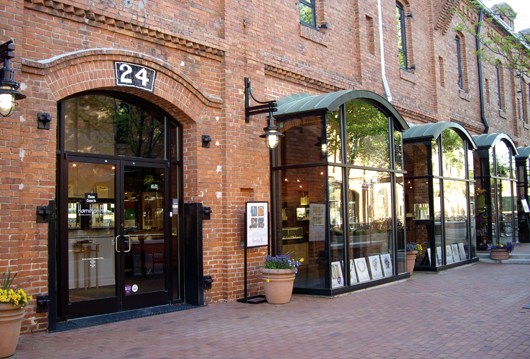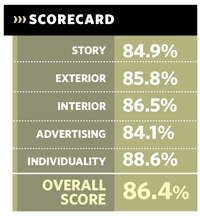
Hamilton Hill International Designer Jewelry
LOCATION: Durham, NC
URL: hamiltonhilljewelry.com
OWNERS: Michael Hamilton and Sarah Hill
FOUNDED: 2001
OPENED FEATURED LOCATION: 2006
EMPLOYEES: 4
AREA: 2,300 square feet
BRANDS: Gellner: the Spirit of Pearls, Henrich & Denzel, Niessing, Atelier Zobel, Etienne Perret, Bikakis and Johns, Dana David, Furrer-Jacot, Somers, Antonio Bernardo
In most cases, an untested belief your customers will share your passion for little-known German, Spanish and Brazilian jewelry designers along with a lack of small-business experience can add up to only one thing: financial disaster. But the story of Hamilton Hill International Designer Jewelry is the retailing equivalent of a love-overcoming-the-odds tale. In less than seven years, Michael Hamilton, a former doctor, and his partner Sarah Hill have built up a thriving business, a clientele — and a store — that share their contemporary aesthetic values. They have discovered and successfully introduced foreign designers to the American market, and attracted a loyal customer base that stretches far beyond their Durham, NC, location thanks to their popular website. To be sure, they are much more prudent today about their buying and inventory management than in their early days. But their overriding love of jewelry as fine art continues to guide their business.
FIVE COOL THINGS ABOUT HAMILTON HILL
The Designers
1At Hamilton Hill, cool starts with the collection of designers, which includes Niessing and Carl Dau from Germany, Majoral from Spain, Amrapali from Jaipur in India, “internationally minded” Americans such as Toby Pomeroy, and Brazil’s Antonio Bernardo (whom Hamilton and Hill are particularly proud of because they were the first American retail store to carry his line). The pieces come in a range of materials (stainless steel to 24-karat gold) and price points (from less than $100 to tens of thousands of dollars) but all share a similar modern sensibility — simple lines, with design dominant over bling. “Our buying practices have become more selective than they were in the early days when our decisions were more likely to be based on intuition and raw enthusiasm,” says Hill, adding with a laugh: “We now have actual clients to keep in mind.”
Warehouse Chic
2The store, the second to carry the Hamilton Hill shingle, is in Durham’s historic Brightleaf Square — a renovated tobacco warehouse ringed by cobblestone and brick walks. The store features bare red-brick walls and massive pine pillars that support a 20-foot-high ceiling. Old tobacco flakes still occasionally float down from the rafters. “It’s not stuffy. The store has intimacy but is large enough so that a person can have a private conversation on one side of the room and not be overheard by other people in the store,” Hamilton says. The pair’s aim was to create a jewelry store with the feel of an art gallery, so they opted for posters and art photography over glossy photographs of jewelry. The jewelry on show is carefully displayed, with lots of space between the cases. Hamilton and Hill designed the interior layout themselves, including all the cases. “We took our inspiration from stores we’d seen here, in Europe and the booths of designers we’d visited at tradeshows,” Hamilton says.
The ‘Faculty’
3Hamilton Hill has possibly one of the mostly highly educated rosters of any jewelry store in America, even if not many of the numerous degrees the staff has collectively amassed have much directly to do with retailing. One member has a degree in electrical engineering, another was the director of nutrition at a Boston academic medical center; another has a degree in landscape architecture; and the most recent staff member has a fine arts degree. Hamilton and Hill are no slouches themselves. Hill, who holds a GIA?graduate gemologist degree, had worked at the Smithsonian?Institution before getting involved in jewelry. Hamilton, a physician, formerly headed an obesity program at Duke Medical Center. Apart from ensuring the staff could comfortably communicate with their regular customers, many of whom work for the universities and research companies that make up North Carolina’s “Triangle” area, the staff’s varied educational background has proved a boon for the store in very practical ways. The former electrical engineer, for example, has proved an invaluable resource in developing the website. Less predictable was how a knowledge of the subtleties of grouping objects in landscape architecture would lead to superb jewelry displays.
Advertisement
Meaningful Marketing
4When it comes to producing advertising, the conventional advice for small-store owners is: Don’t try this yourself. It’s a job for the pros. A quick look at the array of high-quality ads produced by Hamilton Hill would suggest the owners had followed that line. But nearly all their advertising is produced in-house, with Hill conceiving the ideas and a staff member with Photoshop skills executing the production. The bulk of the store’s $100,000 ad budget goes to print, with the leftover split between TV advertising, their website and public radio sponsorships. “I like the control you have on the website” Hamilton says. “In the newspapers, we always seem to end up next to the vein-stripping ads.” The rest of their marketing is directed toward supporting the arts and a wide range of charitable causes, from local orchestras and museums to animal-welfare programs.
Living the Dream
5The coolest thing about the store is maybe the owners themselves. “Yes, we’re focused on profitability,” says Hamilton. “Unless you make money you can’t do the creative things that make having a business exciting.” But at the same time, they’ve been able to stay faithful to their original identity and vision. “We knew it (jewelry retailing) could be very demanding and very risky … but we were so excited about it, passionate about the products we could offer, that we dived in,” Hill says. Hamilton, whose parents were artists, and Hill, who came from an academic household, say they both grew up in homes where the arts, not finance, were discussed around the dinner table. “Had we realized how innocent we were about the difficulties of building a successful business, we might never have acted on our initial vision. We’re glad we took the leap,” Hamilton says.
TRY THIS
No price tags are attached to the jewelry. This is not intended to diminish the presence of price in the sales conversation but to ensure nothing distracts from the carefully constructed displays. Instead, booklets are placed next to each case with illustrated cards of all the pieces. The cards list the jewelry piece, a description and price. “When a piece is sold the card is removed from the book and a new card introduced that corresponds to whatever new piece is placed in the case,” says Hamilton.
HEARSAY
Heard Around the Store
“I’m a browsing associate … Don’t worry, I’m forbidden to sell you anything.”
Advertisement
Michael Hamilton’s response to customers who say they are “just browsing.” It’s a half-serious reference;?he is allowed to sell in limited amounts.
TRUE TALE
One day we were looking for the Stuart Moore jewelry store on Union Street in San Francisco. Mistakenly we started our search in the area of Union Square, miles from the Stuart Moore store. We asked directions in several high-end stores in the area and the response in those stores was courteous but short, “I don’t know.” Finally, we went into a Hermes store (reluctantly because we really looked less than elegant). We were greeted warmly by a young man who also did not know where Stuart Moore was. The difference: he looked up the telephone number, called the store, and wrote down detailed directions for us to follow. From that moment on, we have always tried to give the occasional person who simply wants directions or some other help unrelated to a purchase a warm greeting and as much help as possible. — MICHAEL HAMILTON
WHAT THE JUDGES SAY</h3

Kate Peterson
Management Consultant
I love their marketing! Very clever and attention-grabbing concepts. Sharp, focused displays and showcase layouts really do work! They appear to be maintaining a clear, well-defined brand identity — a rarity in our industry today.
Advertisement
Brad Huisken
Sales Trainer
I’m impressed that the owners had no retail experience and grew the business on pure determination and drive. The store is now recognized both locally and nationally. Its website is very cool in my opinion and I particularly like the store interior and the fact that they carry a good range of products from international designers.
Terry Chandler
Jewelry Educator
Everything old is new again! The combination of contemporary, angular and stark cases inside this historic landmark screams cool! The mind’s expectations are thwarted upon entering and immediately your interest is piqued. Elegant and imaginative, as well as functional! Cool beauty!
Amanda Gizzi
Trend Watcher
The competitive spirit and story of Hamilton Hill was what impressed me the most. Having no retail ownership experience between the owners and not being from the jewelry industry, they took a great leap of faith in opening their store. They also defined a really great niche for themselves. Also, Hamilton Hill has a user-friendly website which accounts for 10 to 15 percent of its business from out-of-town clients looking for its designers. It clearly shows that a website can increase your sales even if the site is not e-commerce.
Renee Singer
Jewelry Wholesaler
Hamilton Hill had a real down-to-earth beginning and a cozy interior to match. It opened right after Sept. 11, 2001, and fought for survival in times of economic uncertainty. By concentrating on designer jewelry, Hamilton Hill was able to find a niche market and build success year after year. This is good advice for jewelry owners: Dare to be different and to try new things. Another notable: Hamilton Hill has an unassuming, contemporary logo and feel-good advertising on its website. Very creative, very cool stuff.
STORE IMAGES
{igallery id=”876″ cid=”208″ pid=”1″ type=”classic” children=”1″ showmenu=”1″ tags=”” limit=”10″}
This story is from the August 2008 edition of INSTORE